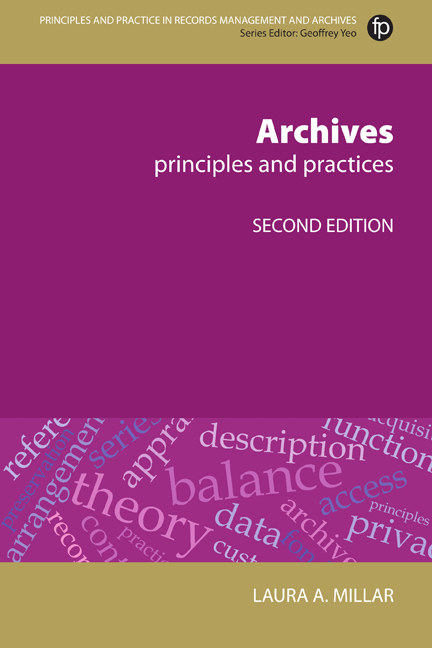Book contents
- Frontmatter
- Contents
- Figures and tables
- Foreword to the first edition
- Foreword to the second edition
- Acknowledgements
- Introduction to the second edition
- PART I ARCHIVAL PRINCIPLES
- PART II ARCHIVAL PRACTICES
- 8 Managing the institution
- 9 Preserving archives
- 10 Acquiring archives
- 11 Arranging and describing archives
- 12 Making archives available
- Conclusion
- To learn more
- Glossary of terms
- Index
- Miscellaneous Endmatter
11 - Arranging and describing archives
from PART II - ARCHIVAL PRACTICES
Published online by Cambridge University Press: 08 June 2018
- Frontmatter
- Contents
- Figures and tables
- Foreword to the first edition
- Foreword to the second edition
- Acknowledgements
- Introduction to the second edition
- PART I ARCHIVAL PRINCIPLES
- PART II ARCHIVAL PRACTICES
- 8 Managing the institution
- 9 Preserving archives
- 10 Acquiring archives
- 11 Arranging and describing archives
- 12 Making archives available
- Conclusion
- To learn more
- Glossary of terms
- Index
- Miscellaneous Endmatter
Summary
Watch out for the fellow who talks about putting things in order! Putting things in order always means getting other people under your control.
Denis Diderot (1713–84) Supplement to Bougainville's ‘Voyage’, 1796Arrangement and description are central to the preservation of archives as documentary evidence. Arrangement and description are also the least stable of archival activities: the ‘best’ way to arrange a collection of archives a century ago is not considered by archivists to be the best way – at all – today.
A Mesopotamian record keeper placed clay tablets into clay pots and onto clay shelves, relying on his memory to know which tablets related to what topics. No one could access the archives without his permission, and only he knew what was there. One suspects he rarely went on vacation. A librarian in 19th-century Connecticut, on the other hand, described manu script collections by writing and filing catalogue cards for each new arrival: a complete description of the materials on a ‘main entry’ card and cross-references to subjects or people in ‘added entry’ cards. Banks and banks of cards filled the archives, and if the front door was opened as the archivist was adding new entries and a stiff wind blew through, half the day was spent picking up cards off the floor and putting them back in order.
Today, the computer is king, and even the smallest and least secure of archival institutions wants to create a database of archival holdings, not put binders of paper finding aids on a bookshelf or add cards to a catalogue in the reference room. (Few institutions rely on clay tablets, though it has been suggested that they are perhaps the most stable medium around these days.) As archives themselves keep changing, the ways in which they can be arranged and described keeps changing. This is why arrangement and description is the area of archival effort most infused with theory, and why those theories can become such contentious areas of debate.
Information
- Type
- Chapter
- Information
- ArchivesPrinciples and Practices, pp. 213 - 242Publisher: FacetPrint publication year: 2017
